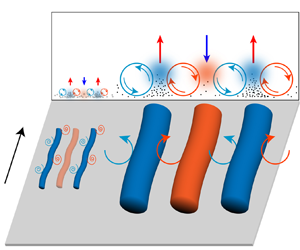Article contents
On the existence and formation of multi-scale particle streaks in turbulent channel flows
Published online by Cambridge University Press: 26 January 2022
Abstract

Direct numerical simulations of particle-laden turbulent channel flows at friction Reynolds number  $Re_\tau$ from
$Re_\tau$ from  $600$ to
$600$ to  $2000$ have been performed to examine the near-wall particle streaks. Different from the well-observed small-scale particle streaks in near-wall turbulence of low
$2000$ have been performed to examine the near-wall particle streaks. Different from the well-observed small-scale particle streaks in near-wall turbulence of low  $Re_\tau$, the present results show large-scale particle streaks through the computational domain formed for relatively high-inertia particles at high
$Re_\tau$, the present results show large-scale particle streaks through the computational domain formed for relatively high-inertia particles at high  $Re_\tau$. Transferred by large-scale sweep and ejection events (
$Re_\tau$. Transferred by large-scale sweep and ejection events ( $Q^-$), these high-inertia particles preferentially accumulate in near-wall regions beneath the large-scale low-speed flow streaks observed in the logarithmic region. The corresponding Stokes numbers are associated with the lifetime of large-scale
$Q^-$), these high-inertia particles preferentially accumulate in near-wall regions beneath the large-scale low-speed flow streaks observed in the logarithmic region. The corresponding Stokes numbers are associated with the lifetime of large-scale  $Q^-$ structures, which increases as the Reynolds number grows. The small-scale particle streaks with a typical Stokes number
$Q^-$ structures, which increases as the Reynolds number grows. The small-scale particle streaks with a typical Stokes number  $St_\nu \approx 30$ are mainly driven by the
$St_\nu \approx 30$ are mainly driven by the  $Q^-$ structures in the buffer layer, whose lifetime is approximately
$Q^-$ structures in the buffer layer, whose lifetime is approximately  $30$ in viscous time unit. Therefore, we propose a new structure-based Stokes number normalized by the lifetime of
$30$ in viscous time unit. Therefore, we propose a new structure-based Stokes number normalized by the lifetime of  $Q^-$ structures of different scales. The relevant flow scales that control the formation of the large-scale particle streaks are parameterized by the structure-based Stokes number. The small-scale (large-scale) particle streaks are most prominent when the buffer-layer (large-scale) structure-based Stokes number approaches unity. The present findings reveal that formation of near-wall particle streaks is governed by the
$Q^-$ structures of different scales. The relevant flow scales that control the formation of the large-scale particle streaks are parameterized by the structure-based Stokes number. The small-scale (large-scale) particle streaks are most prominent when the buffer-layer (large-scale) structure-based Stokes number approaches unity. The present findings reveal that formation of near-wall particle streaks is governed by the  $Q^-$ structures of different scales, and the particles with different inertia respond efficiently to the
$Q^-$ structures of different scales, and the particles with different inertia respond efficiently to the  $Q^-$ structures of corresponding scales with respect to the particle translational motion.
$Q^-$ structures of corresponding scales with respect to the particle translational motion.
- Type
- JFM Papers
- Information
- Copyright
- © The Author(s), 2022. Published by Cambridge University Press
References
REFERENCES
- 27
- Cited by



